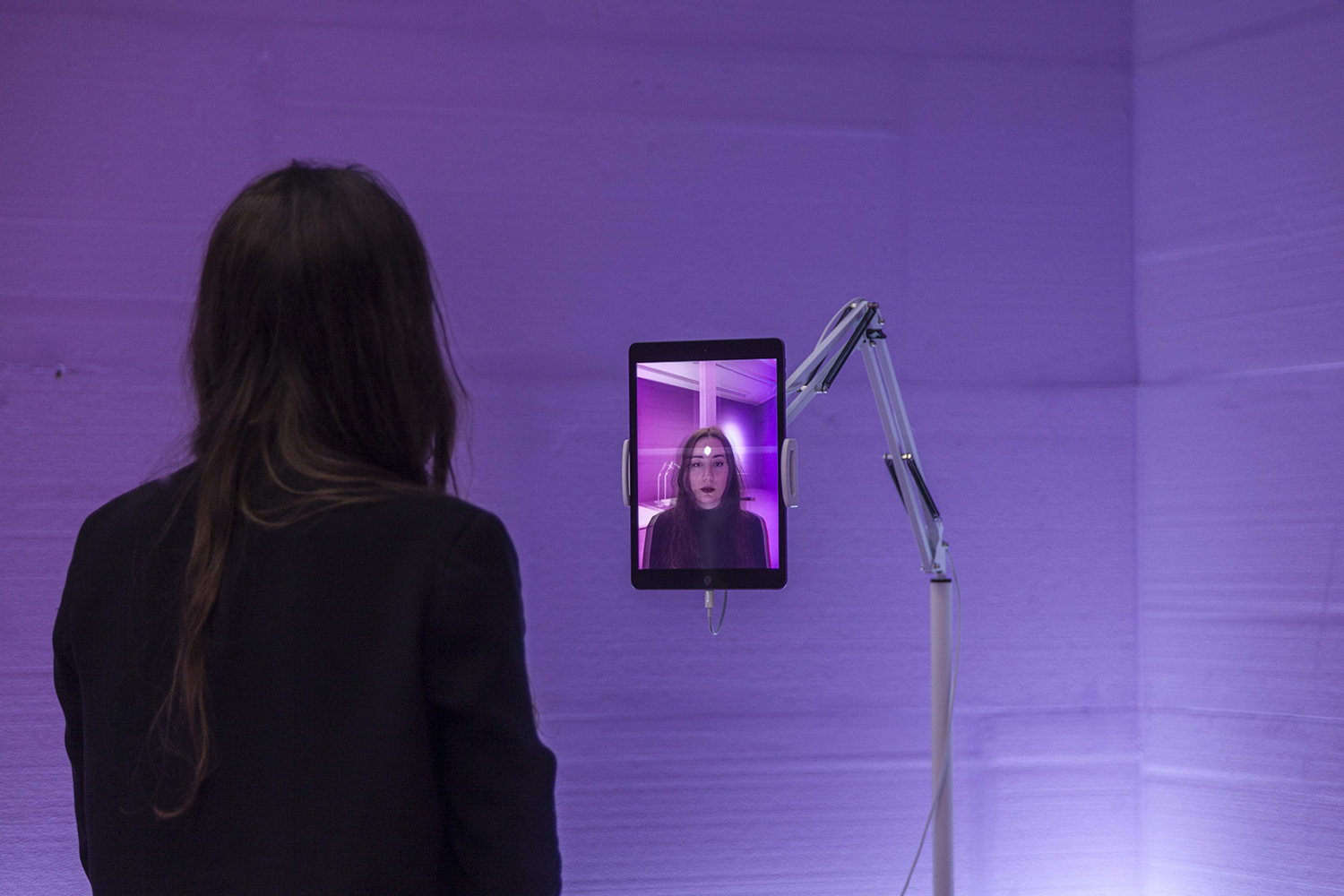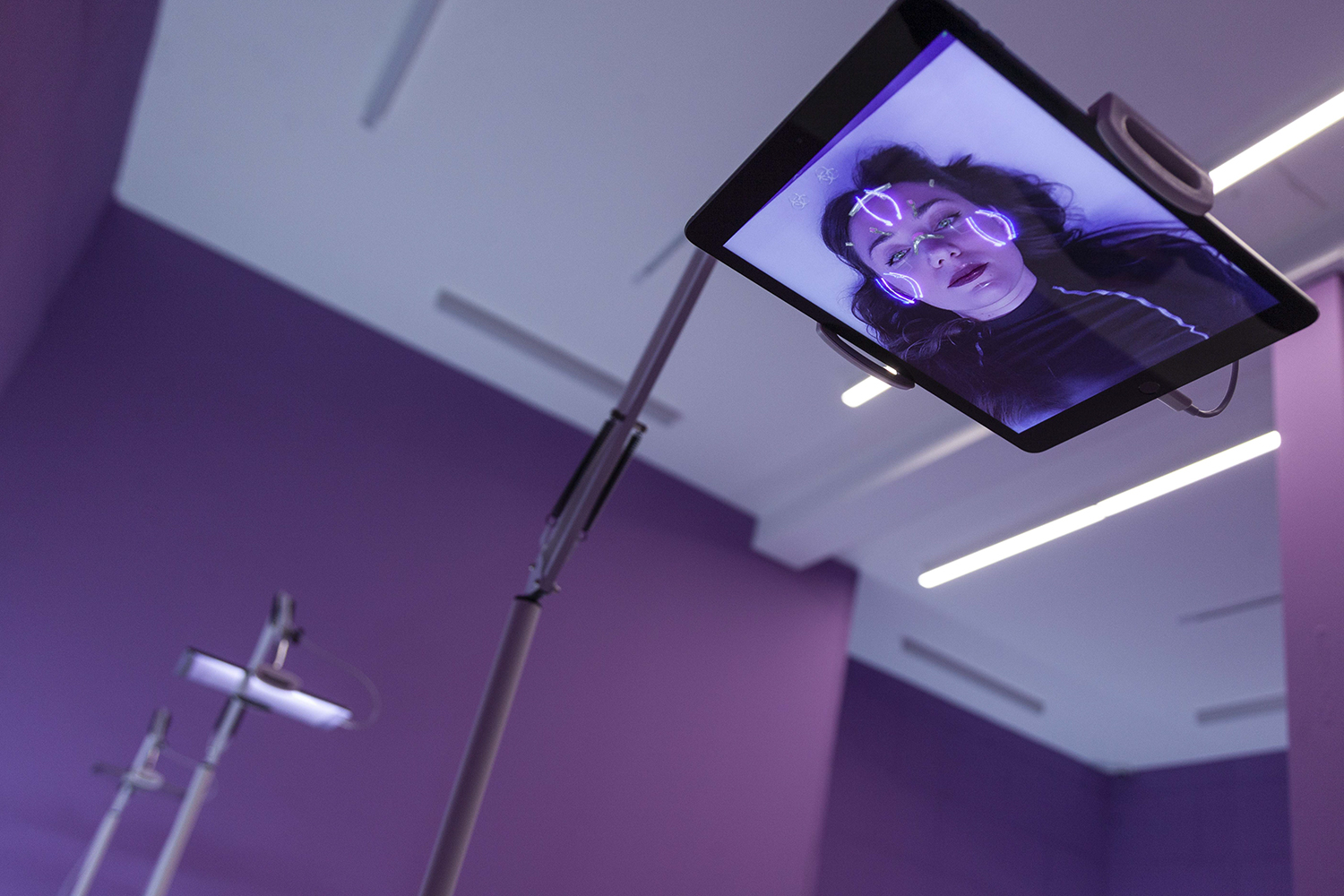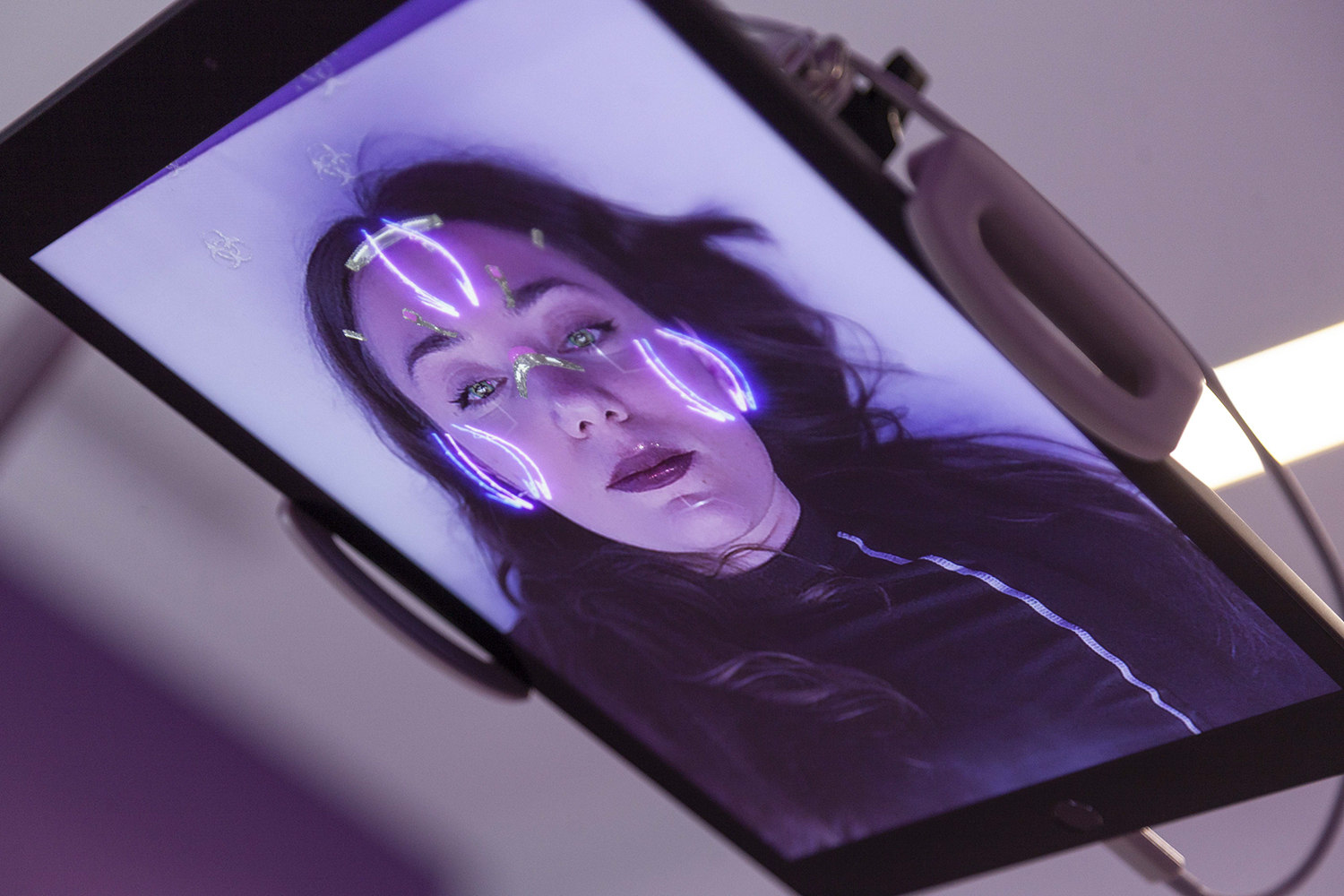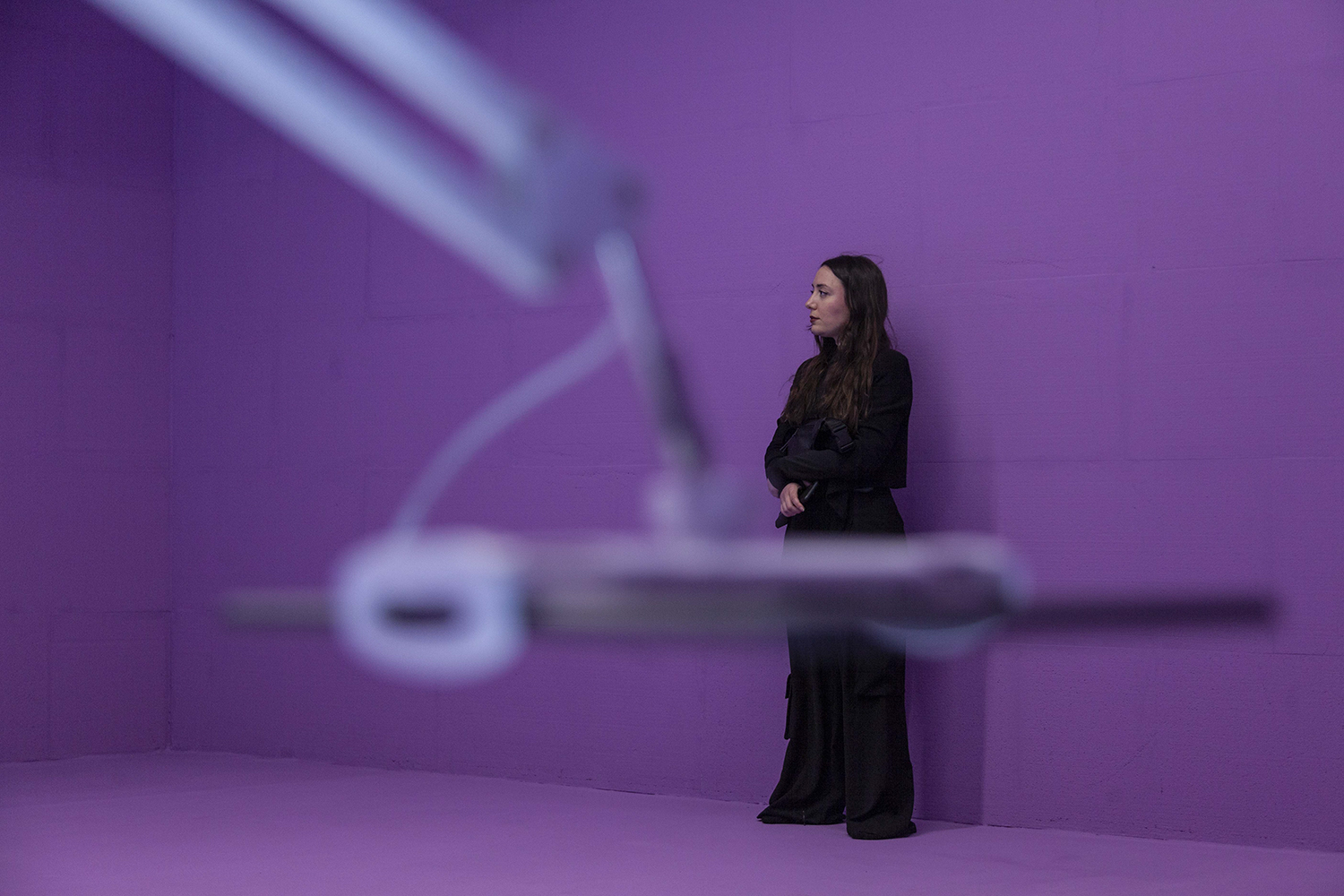Inside the gallery three white beds sit against a backdrop of soft pink walls, resembling something out of a sterile hospital room. Visitors are invited to recline on the beds, adopt a meditative position and gaze at a screen suspended above where they will see an image of themselves with a vulva placed squarely in the middle of their forehead.
The exhibit, with its unconventional and fantastical portrayal of impossible body parts and characters, may seem like something out of a sci-fi flick. Yet, it’s the female body’s concealed vulva that takes center stage.
“This is a bit like the concept of fabulation, which involves using a mix of fiction and reality to explore topics that are often not discussed in society and to reshape and reimagine the world,” said S()fia Braga, who is currently exhibiting her work “Forehead Vulva Channeling Research” at Prishtina’s Galeria 17.
“In this case, the idea was to bring attention to the vulva,” Braga said. “The female body has historically been a taboo subject and has often been considered less important. Placing the vulva on the forehead, a very visible location, gives visibility to this organ.”
On a screen opposite the beds, a video of Braga acting as an ambiguous character who speaks in a futuristic, mechanical voice, explains what the forehead vulva is and how to channel it. Standing next to the screen, Braga told K2.0 that her research for this project showed her the great reverence that was given to the vulva by ancient religions, pointing to a time before the female body became taboo.
“The clirotis I find interesting because it is part of the body that many people don’t know as a shape,” she said. This lack of knowledge about what basic anatomy looks like “tells us a lot about how we talk about the female body,” Braga said. “We know what the brain looks like, why don’t we know what the clitoris looks like? This says a lot about censorship and taboo in general.”

“The idea was to bring attention to the vulva,” Braga said. Photo: Majlinda Hoxha / K2.0.
Braga is a transdisciplinary Italian artist who lives and works between Vienna and Linz. In her artistic work she experiments with new technologies to conceive of speculative fabulations that deal with topics such as transhumanism and non-human agency. Her identity is constantly shifting. Over the last three years she has been “an artist, a cyberstalker, a transhumanist entrepreneur, an AI auteur and has mutated several times into a monstrous creature.”
Her exhibition at Galeria 17 in Prishtina opened on April 4 and runs through June 22. It is a collaboration between Shtatëmbëdhjetë and the Ars Electronica Festival. K2.0 met Braga at Galeria 17 after the opening of her exhibition to discuss “Forehead Vulva Channeling Research,” multiple identities and transmedia storytelling.
K2.0: Could you explain “Forehead Vulva Channeling Research” to me and what we see exhibited here in the gallery.
S()fia Braga: The project is called “Forehead Vulva Channeling Research” and is a speculative transhumanist research project that aims to rediscover new potential in the human body, specifically the possibility of channeling the vulva in one’s forehead. The project builds upon previous research on body transmutation and perception of your own identity. As you may have read in my biography, I define myself differently depending on the project I am working on. My research is also closely related to social media, exploring how we perform with our bodies and construct our identities online.
How can we use this digital space to be something else as well? This is also what “Forehead Vulva Channeling Research” is about. It seeks to challenge the idea of binary thinking, particularly in relation to gender-related topics. Additionally, the project raises awareness about the fact that our bodies are capable of transmutation and transformation. This is where my research intersects with transhumanism, the idea of being able to enhance your body through the use of technology.
For this reason, I have decided to bring this project into augmented reality, as I believe it is crucial to experience the changes in our bodies through such devices, such as the enhancement of the forehead vulva. It is interesting how this technology can enable us to perceive our bodies in new and different ways.

“We know what the brain looks like, why don’t we know what the clitoris looks like?” Braga asked. Photo: Majlinda Hoxha / K2.0.
What makes someone — you in this case — consider themselves a transdisciplinary artist?
I consider myself a transmedia artist because I work with different types of media. I also identify as transdisciplinary because I do not limit myself to the contemporary art world or to any one specific medium. For example, this project began as an online transmedia storytelling experience, which then evolved into a performance and eventually into an installation that incorporates augmented reality video and the performativity of the body. In this project, I am not just the artist and performer; the audience is also a crucial part of the performance. The audience becomes an active participant, transforming the performance into a collaborative experience.
Can you tell us about the steps that have led you to where you are today and to your work in new arts media.
I started studying in Italy and when I started there was no program in new media art, maybe in other countries they already had something going on. So I had very basic visual art courses, but during my first master’s, because I did a second one in Austria, I realized that I was interested in how the dynamics of social media were working.
The idea of working with social media came from the anger I felt about the biases and data collection practices of these platforms. I believed that they violated human rights, so I started to work with these platforms to find ways to subvert them. Initially, I focused on projects related to appropriation and online-based projects, and I started using speculative narratives as a way to tell my story.
I was interested in these topics of new technology and to somehow show the hidden power structures that normally we don’t see, but also the potential that these technologies could have if they would be used by somebody else. If there wouldn’t be a power structure within it, for instance if this technology were open source, then it would be just used in a different way.
This is also a point of using augmented reality in this way. There is face tracking in order to make the project possible, but this data is not collected. This technology has to be used to better yourself and not take away something from you.
It’s clear that the prominent feminist scholar Donna Haraway and her work on the cyborg and the intersection of technology, identity and gender have had a significant impact on your work. However, your biography suggests that you do not necessarily identify as a feminist. What is your perspective on identifying yourself as a feminist artist?
Donna Haraway has had a big influence on my work, particularly her ideas on storytelling. There is this documentary film based on her book, “Story Telling for Earthly Survival,” and it influenced me in this project. I find that storytelling is such a powerful tool to talk about issues that normally aren’t talked about, and it really can help you see the world differently and create shifts in perspective.
I believe that feminists have used this tool, storytelling, as a means to showcase a different world, especially in the past when feminist writers in the 1960s and 1970s were not given the same level of attention as they are today. It was necessary to find ways to [convey their message] beyond simply stating the facts. How can we reimagine something differently? I think it is also easier for people to understand what is wrong when you tell them through a story, and you show them something that can somehow be both utopian and dystopian.

“I was interested in these topics of new technology,” Braga said, “and to somehow show the hidden power structures that normally we don’t see.” Photo: Majlinda Hoxha / K2.0.
When you read my biography and projects you may not find the term ‘feminist.’ I do not feel the need for such labels, but definitely I am part of it. But at this point, everybody should be. Because feminism is not just about the empowerment of women but also older people, minorities and it has become a much bigger movement that is constantly changing.
For instance, I don’t align myself with the first wave of feminism. I think these are far away from my ideas, I have a more contemporary understanding of feminism that goes beyond what was before and I dislike labeling.
I want to address a specific point from your presentations, that of a constantly changing identity. Over the last three years you’ve said that you have been ‘an artist, a cyberstalker, a transhumanist entrepreneur, an AI auteur and have mutated several times into a monstrous creature.’
Nobody has a singular identity, because we always change and develop depending on the experiences we have. But somehow there are some labels that we decide to put on ourselves. For instance, you will never be an artist until you yourself say you are an artist. You cannot expect another person to come to you and say ‘you are an artist,’ if you have not said it first.
It was a big topic of discussion when I was studying with my colleagues, as you need to overcome some fears and possibly imposter syndrome, in order to declare yourself an artist. But in the end, it’s just a label that you can apply to yourself. You can choose to call yourself something else and become that person instead.
So when I started working in this process that is more related to appropriation and when I was taking screen recordings from digital platforms and using them for artistic purposes, I really felt like a cyberstalker and liked the idea of defining myself as one, to enter the character.
My projects are mostly installation based, but there is always this performative act, so I think I enter the project better when I believe I am a transhumanist entrepreneur. We are always in a process of changing and I need to change in this way.

Braga’s exhibition is open at Galeria 17 until June 22. Photo: Majlinda Hoxha / K2.0.
Despite having multiple identities, individuals often feel a strong attachment to certain aspects of their identity, such as their gender and ethnicity, which isn’t apparent in your case.
For instance, I really don’t like to define myself as a woman. I really don’t feel a necessity to tick the box that says I am a woman. I don’t think this is an important piece of data.
I have written in my biography that I am an Italian artist, but I often think I should remove it. Why do people need to know where I come from? I honestly don’t appreciate when others ask where you come from.
Why would I identify myself as my country? It is not me. My culture comes from there, and probably it defined me, but I am not Italy, I am not Austria.
I think in this sense I like to define myself as an artist. I also like to define myself with labels that people normally wouldn’t use, such as when I say I mutated into a monster, also to play with this notion of identity.
You work with various technologies in your work. How do you feel about the recent discourse on the ethical implications of AI?
I am bothered by the fact that technology is not neutral and that AI is built by people who reflect their own biases. Typically, these individuals are white men from California. As a result, technology discriminates against people from the Global South and women. This impact is clearly visible.
This is what is fundamentally important to acknowledge, even though my work would not exist without it. I hope that technology will continue to evolve and improve, not only to avoid unfulfilling work but also to enhance our personal growth and free up time for other pursuits. But, at present, it’s important to underline the fact that technology is not neutral.
This article has been edited for length and clarity. The conversation was conducted in English.
Feature image: Majlinda Hoxha / K2.0.





